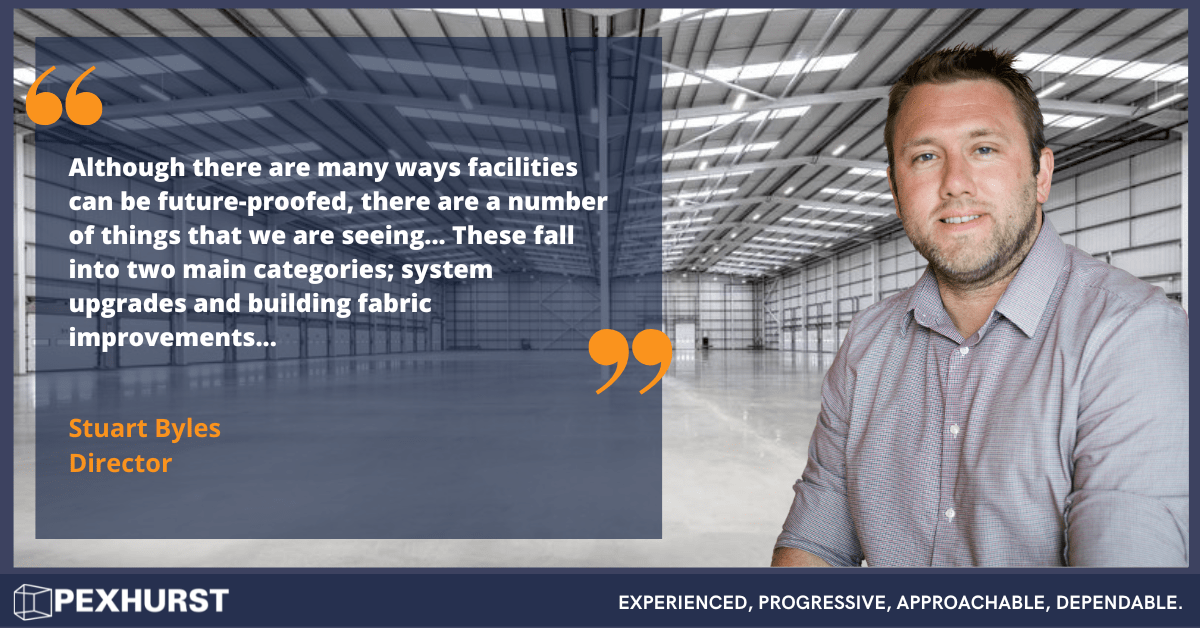Ahead of upcoming regulatory changes around EPC ratings on commercial facilities, we recently sat down with Director Stuart Byles to find out all you need to know about future-proofing sheds during a refurbishment…
What is at the front of people’s minds when it comes to future-proofing big sheds?
First and foremost, there is of course the need to consider evolving regulations – such as with EPC ratings – and ensuring facilities meet statutory compliance requirements. But this is just one of the factors that will be in the minds of asset owners and their tenants.
Cost and value also have a big role to play here. Energy efficient facilities are not only going to be worth more as an asset to landlords, but they will also cost less to run for tenants – a win-win situation.
If you were creating a tick list of EPC quick wins, what would you urge everyone to do when future-proofing their facilities?
Although there are many ways facilities can be future-proofed, there are a number of things that we are seeing, and doing ourselves, across the board. These fall into two main categories; system upgrades and building fabric improvements.
Internally, it all starts with stripping out old and inefficient heating systems that rely on fossil fuels, such as wet heating systems. These can then be upgraded with the installation of electric heating systems, such as air source heat pumps or panel heating. Small power and lighting demands can also be overcome by moving to energy efficient options such as LED lighting and PV panels.
When it comes to improving the building fabric, much of this comes down to improving insulation between heated and unheated areas such as the warehouse floor and office space. We can also switch out sectional doors and add oversheeting to the roof to improve thermal performance.
The key consideration here is whether these improvements can be carried out when the unit is occupied. Whilst nothing is impossible, it is of course easier and more efficient to complete these upgrades on an empty shed to limit disruption to tenants. Because of this, we are seeing more clients taking on longer term estate regeneration schemes using a staged approach, completing upgrades on one unit at a time as tenancies come to an end.
The minimum EPC rating for commercial properties is set to rise from ‘E’ to ‘C’ in 2027, and then to ‘B’ from 2030. How do you think this will impact the industrial and logistics sector going forward?
What we are already seeing from a refurbishment point of view is landlords and asset owners falling into two camps – those who simply see it as a matter of compliance, and those who consider it a real opportunity to increase their asset value and strive for EPC A+.
The latter is the way to do it. Despite the consultation outcomes remaining uncertain as it stands, it feels like a no-brainer to work towards the ‘B’ minimum standard for 2030 and unlock the benefits sooner. We’ve been given the time and opportunity to meet and exceed these requirements, so why not seize the opportunity to help attract the right tenants that will pay the right price.
Does automation have a role in future-proofing big sheds? Is this approached differently in new vs refurbished units?
With many big retailers opting for automated pick and pack machines, sheds need to be equipped for the associated load. For this reason, many opt for new build units that are built for this purpose. However, this isn’t to say it’s not possible to reach these standards when completing a refurbishment.
When refurbishing older units, we have also been known to increase the roof height to allow for racking, again used in distribution centres by manufacturers or retailers. This is something we undertook at Unit A Woolborough Lane, Crawley to ensure it appealed to a wide range of tenants.
What kinds of infrastructure needs to be installed to ensure large units are fit for future requirements?
In the process of moving away from fossil fuels, the main consideration needs to be provision and supply of electricity. Simply put, the power supply to older units is no longer sufficient once you’ve upgraded to electric heating and cooling systems along with the installation of EV charging stations.
With an increased appetite for sustainable development, and an uptick in projects striving for the highest EPC and BREEAM ratings, it is exciting to see asset owners and contractors working together to future-proof properties. We look forward to seeing how this continues to evolve as new regulations come into effect and the industry continues to take strides towards net-zero.
To find out more about our industrial and logistics refurbishment services, visit: https://www.pexhurst.co.uk/services/warehouse-refurbishment/










